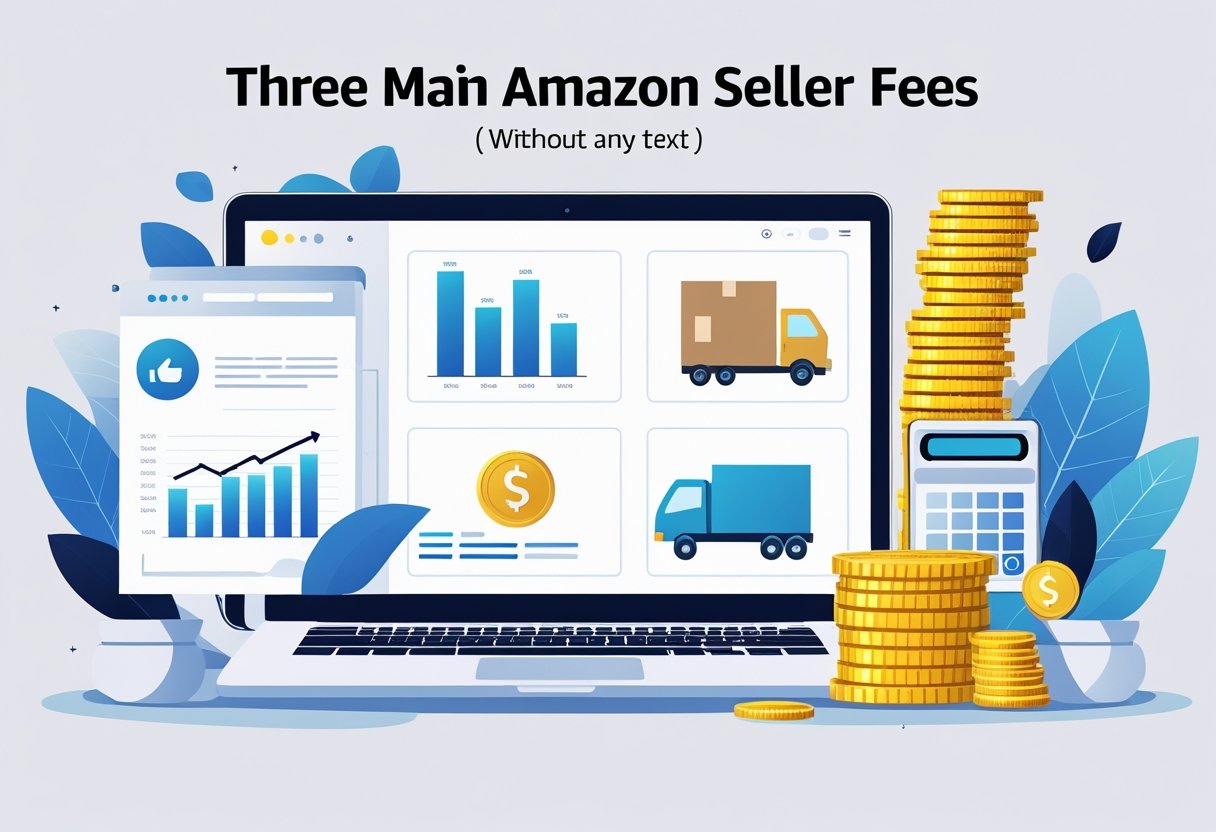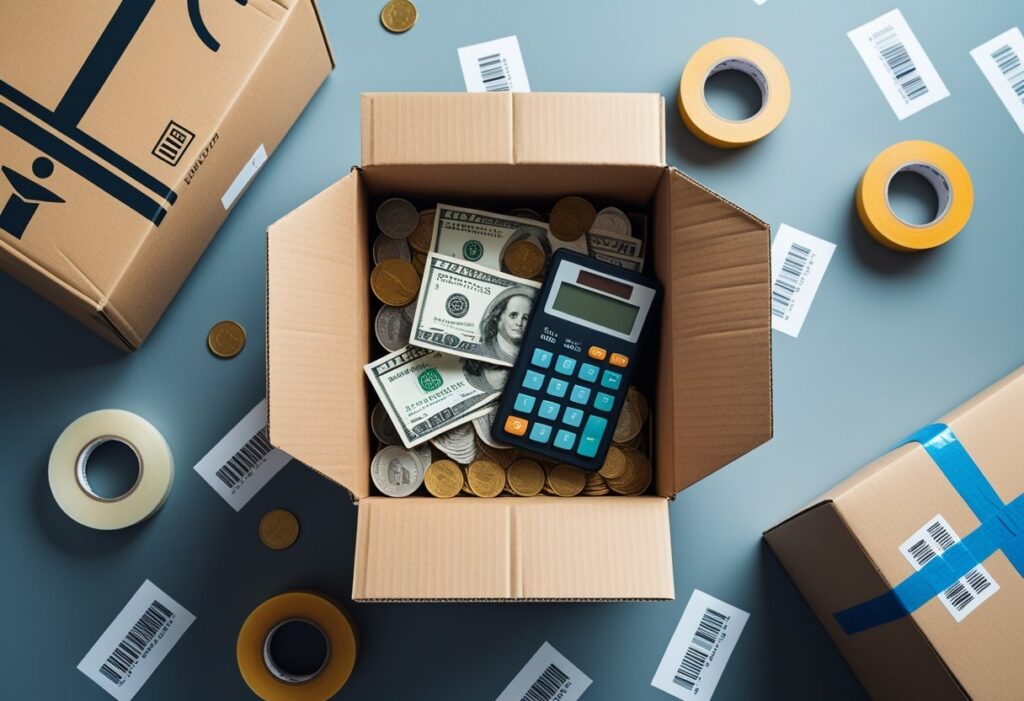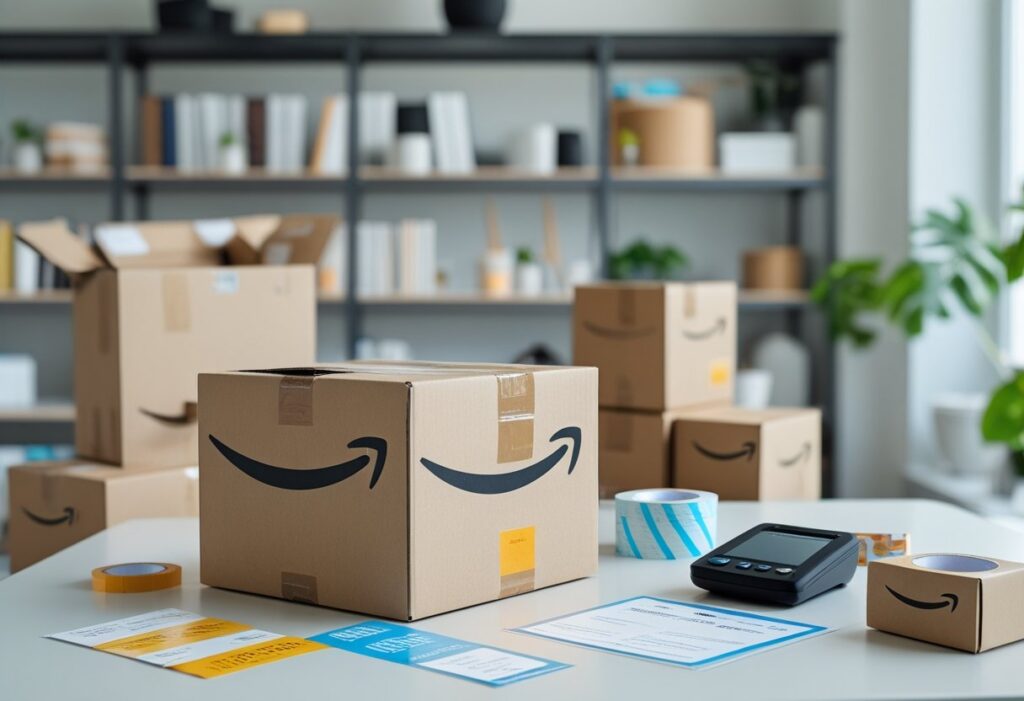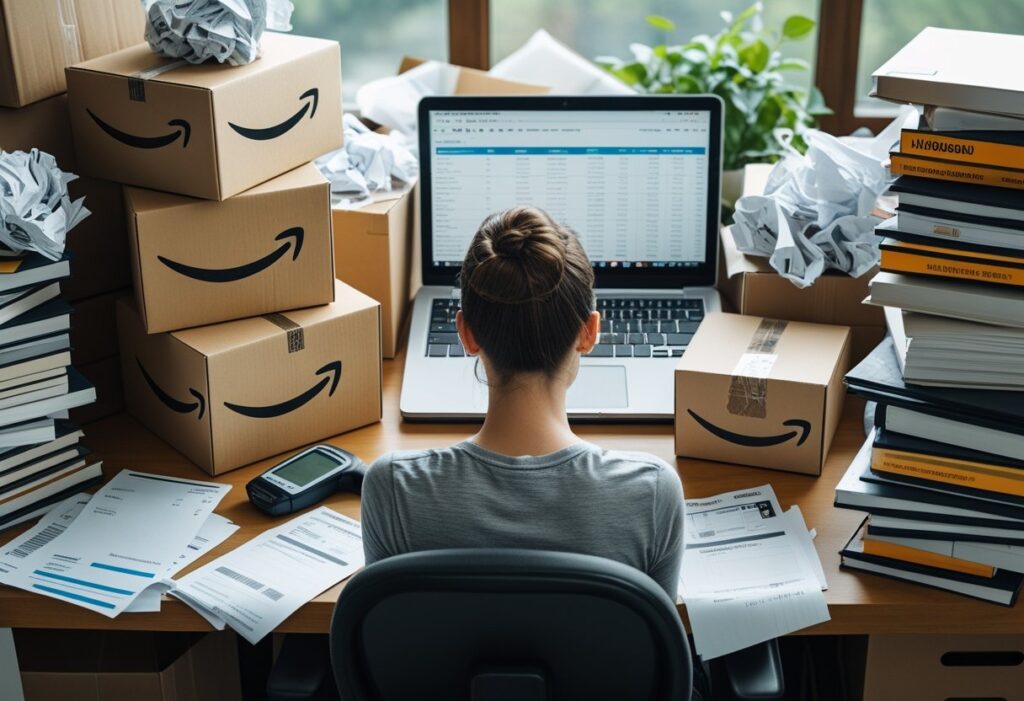Selling on Amazon seems pretty straightforward at first glance. You list a product, make a sale, and the money should just roll in, right?
But honestly, a lot of new sellers get blindsided when profits shrink because of all sorts of fees they didn’t see coming. If you don’t really get how Amazon’s fees work, you could end up losing money even when your sales look solid.

I want to break down the main fees you’ll run into, like referral fees, FBA fees, and storage costs. Plus, there are these sneaky hidden charges that catch a lot of beginners off guard.
I’ll use real examples of how these fees stack up in actual transactions. And I’ll throw in some practical ways to cut costs without wrecking your business.
Key Takeaways
- Amazon fees can eat into profits fast if you don’t plan ahead.
- Knowing both the obvious and hidden fees helps you manage costs better.
- Some fees are actually worth it if they save time or help boost sales.
Why Fees Matter For New Sellers
When I first jumped into selling on Amazon, I realized pretty quickly that fees decide how much I actually get to keep. You might make a bunch of sales, but if the costs are high, your earnings can vanish.
That’s why I obsessively check every fee on my seller account. Referral fees? They’re usually about 6–20% of each sale, depending on the category.
Let’s say I sell a $50 pair of headphones with a 14% referral fee. That’s $7 gone right off the top, before I see a dime.
When it comes to the Professional Selling Plan, it’s $39.99 a month instead of $0.99 per item. For me, it only makes sense if I’m moving more than 40 products a month.
Otherwise, I just stick with the Individual plan. As an Amazon FBA seller, I also have to deal with fulfillment and storage fees.
These cover picking, packing, and shipping, but they can add up fast—especially if my items are big or sit in storage too long. For example:
- Small item (1 lb): about $2.50 per unit
- Large item (2 lb): about $4.70 per unit
- Storage (Oct–Dec): higher rates because of holiday demand
Honestly, those numbers look small, but over 100 sales, they can chop hundreds off my profit.
I’ve learned that understanding fees helps me make better decisions. Sometimes paying more for FBA is totally worth it for Prime shipping, better search placement, and not dealing with packing boxes myself.
Other times, self-fulfillment just saves me more money. It’s a balancing act.
Quick Preview Of What Will Be Covered
In this post, I’ll walk through the main Amazon seller fees so you know what you’re getting into before you start. We’ll cover referral fees, FBA fees, storage fees, and the hidden costs that trip up a lot of new sellers.
I’ll toss in real examples with numbers—like what actually happens when I sell a $25 item through Amazon FBA and how much is left after all the fees.
You’ll also get a quick table that compares different fee types side by side:
| Fee Type | What It Covers | Example Impact |
|---|---|---|
| Referral Fee | Amazon’s cut per sale | % of product price |
| FBA Fee | Packing and shipping costs | Based on size/weight |
| Storage Fee | Space used in Amazon’s warehouse | Charged monthly |
| Hidden Fees | Returns, long-term storage, etc | Varies by case |
I’ll share practical tips for lowering these fees, like picking the right product sizes, watching storage times, and weighing FBA against FBM (Fulfilled by Merchant).
The 3 Main Amazon Seller Fees

When I sell on Amazon, it’s not just about setting a price and hoping for the best. There are three main fees that come out of every sale: Amazon’s percentage cut, the cost for them to handle shipping, and what they charge for storing my stuff in their warehouses.
Referral Fees
Amazon takes a referral fee on every item I sell. It’s basically their commission for letting me use their giant marketplace and reach their customers.
The fee is a percentage of the total sale price (including shipping). Most categories are between 8% and 15%, but some get way higher. Amazon device accessories, for example, can hit 45%.
Example: If I sell a $40 kitchen tool with a 15% referral fee, Amazon keeps $6. That comes out automatically before I ever see the money.
I always double-check the referral rate for my product category using Amazon’s official fee schedule. Otherwise, you can get caught off guard.
Fulfillment Fees (FBA)
If I use Fulfillment by Amazon (FBA), I pay them to pick, pack, and ship my orders. The cost depends on size and weight. Smaller, lighter stuff is cheaper; big or heavy stuff costs more.
Example: A standard-size item under one pound might run me around $3 to fulfill. A bulky item could be $8 or more.
FBA fees also cover customer service and returns, which honestly saves me a ton of hassle. But if my margins are thin, these charges can wipe them out fast.
To keep these costs down, I try to:
- Use compact packaging so I stay in lower size tiers
- Bundle products when I can to lower per-unit fees
- Compare FBA to self-fulfillment (FBM) for heavy or awkward products
Storage Fees
When I send inventory to Amazon fulfillment centers, I pay storage fees based on how much space my stuff takes up. Fees are monthly and measured in cubic feet.
From January to September, the rate for standard-size items is about $0.87 per cubic foot. In October to December, it jumps to about $2.40 per cubic foot because of the holidays.
There’s also an aged inventory surcharge if my products sit there for more than 181 days. For example, if I have 100 units over 200 days old, that could be $50 a month extra, on top of the regular storage fee.
My best tricks for avoiding storage fees getting out of control:
- Ship in smaller batches more often instead of sending a ton of stock at once
- Track inventory age in Seller Central
- Run discounts to move slow items before those surcharges kick in
- Use removal orders to pull back unsold products if I need to
Other Hidden Or Overlooked Fees
When I first started selling, I didn’t realize there were all these extra fees hiding in the background. They don’t seem huge at first, but they can pile up—depending on what I sell, how I handle returns, or if I use Amazon’s prep or removal services.
Closing Fees (Books/Media)
If I’m selling books, DVDs, music, or video games, Amazon hits me with a closing fee. It’s a flat charge per item, separate from the referral fee. Right now, it’s about $1.80 per sale in these categories.
For example, if I sell a used book for $10, Amazon takes the 15% referral fee ($1.50) plus the $1.80 closing fee. That leaves me with $6.70 before shipping or anything else.
This fee really eats into profits if I’m selling low-priced stuff. A lot of sellers doing retail arbitrage with cheap books or DVDs see their margins disappear. I try to focus on higher-priced books, or bundle items to spread that fee out a bit.
Returns Processing
When a customer returns something in categories like clothing, shoes, jewelry, or luggage, Amazon charges me a returns processing fee. It’s the same as the original fulfillment fee I paid when the item shipped.
Here’s how it plays out:
- I sell a pair of sneakers.
- Amazon charges me $5.50 to fulfill and ship the order.
- The buyer returns them.
- I get charged another $5.50 as a return processing fee.
It doesn’t matter if the item comes back in perfect shape—I still pay. So I’m extra careful with categories that get a lot of returns, like apparel. I also make sure my product descriptions are clear and my sizing charts are accurate to help cut down on unnecessary returns.
Labeling/Prep Service
Amazon wants every FBA product to have a scannable barcode. If I skip labeling items myself, Amazon’s FBA Label Service will do it, but it’s about $0.30 per unit.
That might seem minor, but if I send in 1,000 units from an online arbitrage score, that’s $300 gone just for labeling. Ouch—over time, that adds up and definitely nibbles at the profits.
I usually print my own labels and stick them on before shipping. Some folks use third-party prep centers, which can be cheaper, especially if I’m shipping in bulk or dealing with Pan-European FBA (where labeling rules can get a bit weird).
Removal/Disposal Fees
If stuff isn’t selling (or I just don’t want to rack up storage fees), I can tell Amazon to return or toss my items. Both options come with a removal or disposal fee per unit.
The fee depends on size and weight. For example:
- Small standard-size item: about $0.50 per unit
- Oversized item: $1.00 or more per unit
When I’m testing products through retail arbitrage and they flop, these fees can sneak up fast. I do my best to check demand before I ship a ton of something. Sometimes, honestly, it’s smarter to pull inventory out and resell it somewhere else than let storage costs keep stacking up.
Real Example Of Amazon Fees In Action
For me, Amazon fees make more sense when I can actually see the math. Breaking down a single product is the only way I wrap my head around what’s left after all the deductions.
Walk Through A $25 Product Example
Let’s say I list a phone case for $25 and use Fulfillment by Amazon (FBA).
The main costs shake out like this:
- Referral fee (15%): $3.75
- FBA fulfillment fee (small standard item): about $3.22
- Monthly storage fee: around $0.10 per unit
- Shipping to Amazon: $0.50 per unit
- Product cost from supplier: $5
Amazon takes the referral and fulfillment fees right off the top. Then I’ve still got my own product and shipping costs to cover.
Show How Much Is Left After Amazon Fees
Here’s what’s left after everything comes out of that $25 sale price:
| Item | Cost |
|---|---|
| Sale Price | $25.00 |
| Referral Fee (15%) | -$3.75 |
| FBA Fulfillment Fee | -$3.22 |
| Storage Fee | -$0.10 |
| Shipping to Amazon | -$0.50 |
| Product Cost | -$5.00 |
Profit = $12.43 per unit
So, after all that, I keep just under half of what I sold it for. Not terrible, but it’s a good reminder that you’ve got to know your numbers or the profits can vanish before you even notice.
If the product was heavier or bulkier, that fulfillment fee could really bite into what’s left. It’s always a balancing act.
How To Reduce Amazon Seller Fees
My main strategy for keeping costs down is picking the right products, staying on top of storage, tracking fees, and sending inventory with a plan. It’s not rocket science, but it works.
Pick Smaller/Lighter Items
Size and weight are a big deal on Amazon. The heavier or bigger the thing, the more FBA charges to store and ship it. A tiny product is just cheaper to handle all around.
Take a phone case versus a blender. The case is lighter, ships for less, and barely takes up space. That’s more profit for me, less cash for Amazon.
I aim for Amazon’s “standard-size” category whenever I can. It’s usually the sweet spot for lower fulfillment fees.
What I look for:
- Products under 18 x 14 x 8 inches
- Under 20 pounds
- No need for fancy or extra packaging
Compact products keep my fees down and make shipping easier for everyone.
Avoid Long-Term Storage
Amazon isn’t shy about charging extra when inventory sits too long. After 181 days, storage fees start climbing, and after a year, they really jump.
I try to keep tabs on how quickly stuff is selling. If something’s stuck, I’ll drop the price or bundle it to move it faster.
One time, I got stuck with a bunch of seasonal items that didn’t sell. I bundled them for a discount, moved them out, and dodged those long-term storage fees. Not my finest moment, but it worked.
My go-to tips:
- Check inventory age in Seller Central
- Run sales before hitting that 6-month mark
- Don’t send in more stock than I need
Staying active with my listings keeps storage costs from quietly draining my profits.
Use Fee-Tracking Tools
Amazon’s fees can sneak up in weird ways. That’s why I use fee-tracking tools to see exactly where my money’s going. They break down referral fees, FBA costs, storage, even those random little charges I’d otherwise miss.
One time, I realized a product was getting hit with higher shipping. The fee calculator showed the packaging size pushed it into a pricier tier. I changed the box and saved a few bucks per order. Small fix, but it added up fast.
Some tools I like:
- Amazon Revenue Calculator (free)
- Helium 10 Profits
- Jungle Scout Profit Dashboard
With these, I can make smarter calls and avoid those “wait, where’d my money go?” moments.
Plan Inventory Wisely
Good inventory planning is everything. Too much stock, and I’m paying to store dust. Too little, and I miss out on sales.
I use past sales data to guide my shipments. If I sold 200 last month, maybe I’ll send 220 this time to cover a little growth. It’s not perfect, but it keeps me balanced.
Seasons matter too. I’ll load up on outdoor gear before summer, then slow down in the fall. Keeps me from paying for space I don’t need.
My quick checklist:
- Check sales history every month
- Adjust for the season
- Keep enough for 4–6 weeks at Amazon
Planning keeps my costs predictable and my stuff in stock when people actually want to buy it.
When Paying Amazon Fees Is Worth It
Honestly, some Amazon fees are just worth it. They save me time, lighten my workload, and sometimes actually help me earn more than if I tried to do everything myself.
How Amazon Saves Sellers Time
With the Amazon FBA business model, I pay for storage, packing, and shipping. At first, those fees felt like money down the drain, but I’ve come to appreciate the time I get back by letting Amazon handle the messy stuff.
I’m not picking, packing, or shipping orders. No dealing with customer service headaches, lost packages, or returns. Amazon does all that, so I can focus on finding new products, tweaking listings, or running ads.
Here’s what I don’t have to do anymore:
- Buy boxes, tape, packing supplies
- Print and stick shipping labels
- Wait in line at the post office
- Answer customer emails about late deliveries
It’s easy to underestimate how much time those little tasks eat up. With FBA, I get to spend my time on stuff that actually grows my business.
Why The Trade-Off Can Still Be Profitable
Even though Amazon charges referral fees (usually 8–15%) and fulfillment fees, I kind of see them as my ticket to a huge marketplace. Millions of shoppers already trust Amazon, so my products get exposure I’d never get on my own.
For example, if I sell a $20 phone case, Amazon might take around $6 in fees. That leaves me $14 before product costs. If I tried to drive my own traffic, I’d probably spend more than $6 just getting a single sale.
There’s also the Buy Box advantage. With FBA and a Professional plan, my listings are more likely to win the Buy Box, which is where most Amazon sales happen. Even if the fees feel steep, the extra sales volume can make up for it.
So, yeah, the trade-off is about scale. Paying the fees can actually boost my net profit, since Amazon brings me reach, trust, and tools I’d never build on my own.
Key Takeaways
The biggest fees to watch are referral fees, FBA fees, and storage fees. Referral fees are a chunk of each sale—usually 8–15%. FBA fees cover picking, packing, and shipping, while storage fees depend on how long stuff sits around in the warehouse.
I always track these because they can eat up profit if I’m not paying attention. For example, sending slow-moving products to FBA racks up extra storage charges. To avoid that, I only send enough stock for a month or two and restock as needed.
A few ways I cut fees:
- Bundle products—pay one referral fee instead of several.
- Use smaller packaging to lower FBA fulfillment costs.
- Clear out inventory before long-term storage fees hit.
Even with all these costs, letting Amazon handle shipping and customer service usually frees me up to focus on finding new products. For me, that trade-off is worth the fee more often than not.
Encourage Readers To Learn More Through The Full FBA Course
What I’ve shared here just scratches the surface. If you’re aiming to really succeed as an Amazon seller, there’s a lot more to it.
Inside my full FBA course, I dive into every fee category, walk through real seller dashboards, and break down profit strategies step by step. I try to keep things practical, not just theory.
I’ve also included worksheets for margin calculations, side-by-side FBA vs. FBM comparisons, and smarter inventory planning. These tools help you see exactly where your money’s going—and, hopefully, how to keep more of it.
Frequently Asked Questions
People always ask about the maze of Amazon seller fees, how they’re calculated, and if they’re worth it. The big topics? Referral fees, FBA costs, storage charges, random extra expenses, and what you actually get in return.
What are the different types of fees I’ll encounter as a new Amazon seller?
When I first started, I was surprised by how many fees there actually are.
- Referral fees: Amazon takes a percentage of every sale you make.
- FBA fees: These cover picking, packing, and shipping if you use Fulfillment by Amazon.
- Storage fees: You’ll pay for keeping your inventory in Amazon’s warehouses.
- Other costs: Think returns processing, labeling, or long-term storage charges.
They can add up fast, so it’s worth tracking them closely.
Can you break down how Amazon referral fees work with examples?
Referral fees usually land somewhere between 8% and 15% of your item’s selling price, and it really depends on the category.
Here’s what that looks like in practice:
- Sell a $30 phone case at a 15% referral fee? Amazon keeps $4.50.
- A $200 blender in a 10% category means a $20 fee.
I always check Amazon’s fee schedule before I list, just to avoid any nasty surprises with profit margins.
How are FBA fees calculated, and are there tools to help estimate them?
FBA fees are mostly about size and weight. Smaller, lighter stuff is cheaper to ship; big or heavy items cost more.
For instance, shipping a small toy might run me about $3, but a bulky vacuum cleaner could be over $10. That adds up if you’re not careful.
I rely on Amazon’s free FBA Revenue Calculator to estimate these costs before I send anything in. It’s honestly a lifesaver for figuring out if something’s even worth selling.
What are the typical storage fees for Amazon FBA, and how can I minimize them?
Amazon charges storage fees every month, and it’s all about the space your items use. October through December? Those rates jump because of the holidays.
Here’s what I do to keep storage costs down:
- Send in smaller shipments more frequently.
- Pull out slow-moving stock before it racks up big fees.
- Keep a close eye on inventory using Amazon’s inventory dashboard.
Are there any hidden costs in selling on Amazon that I should be aware of?
Oh, definitely. I’ve been caught off guard by a few fees I didn’t see coming at first.
- Returns processing fees—certain categories get hit with these.
- Labeling fees—if you don’t prep your stuff just right, Amazon will charge you.
- Long-term storage fees—for products that sit more than 12 months.
They’re not exactly hidden, but if you don’t plan ahead, you’ll feel them.
Why might higher Amazon seller fees be justifiable and beneficial for my business?
Even though fees can feel high, I see value in what I get.
Amazon gives me access to millions of customers, trusted payment systems, and fast Prime shipping.
These services act as trust signals that help buyers feel confident when they purchase from me.
Honestly, paying fees often makes sense because the sales volume and customer trust I gain usually outweigh the costs—at least that’s been my experience.



